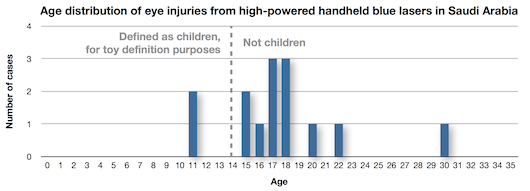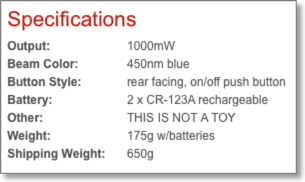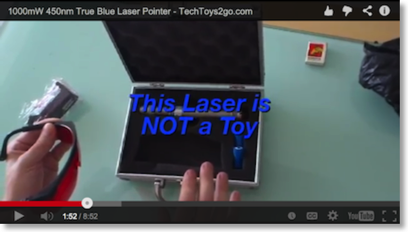Home
A comprehensive resource for safe and responsible laser use

An analysis of the AAO’s press release claiming there are high-powered handheld blue laser toys
(Note: this page provides some additional supporting evidence and discussion for the page “Are laser toys an actual hazard?”)
On December 5 2013, the American Academy of Ophthalmology issued a press release entitled “High-Powered Handheld Blue Laser Toys Can Cause Serious Eye Injuries.”
As discussed on this page, and related links, such high-powered handheld blue laser toys do not exist.
More specifically, in doing an online search, we found no high-powered handheld lasers of any type that were marketed as toys. The AAO provided one marginal case of “children’s entertainment” but not specifically toys (as discussed below).
In addition, the AAO’s release claimed that these high-powered blue handheld laser devices “are often marketed as toys”. They base this on an as-yet unverified statement by doctors in Saudi Arabia about marketing of lasers, which appears likely to be untrue.
Background of the claim
The AAO’s “blue laser toys” press release was publicizing an article published online Nov. 4 2013 by AAO’s journal Opthalmology, It described 14 persons in Saudi Arabia who had eye injuries from playing with a high-powered blue laser device (claimed to be 450 nm and with power between 150 to 1200 mW).
The study itself is interesting. The 14 injuries were treated January 2012 to January 2013 at one hospital in Saudi Arabia. This is by far the largest number of eye injuries from laser pointer or handheld laser misuse reported at one time in one location. In the U.S., there have been only a few such reports, and never localized like this. So the Saudi situation is already unusual.
86% of injuries were not to children
Most persons injured in the Saudi cases were not children. Twelve of the 14 injuries occurred to someone older than 13 years of age:

This indicates two things: (1) These devices in Saudi Arabia were primarily misused by teens and young adults -- not children. (2) Any laws designed to restrict laser devices to children would not have helped in the vast majority (86%) of these cases. (In June 2013, the FDA proposed new controls on “children’s toy laser products” that are “manufactured, designed, intended or promoted for use by children under 14 years of age.”)
The lasers were not marketed as toys
In their paper, the Saudi doctors claimed “These handheld laser devices often are marketed as toys.”
In mid-December 2013 LaserPointerSafety.com and AAO both wrote to the Saudi doctors, asking for the underlying reference(s) for this statement. For example, this might be a list of websites or other marketing materials where high-powered lasers were being sold as “toys”. We also asked for the basis of stating they are “often” marketed as toys. As of this writing (Jan. 7 2014), there has not yet been a response from the Saudi doctors
We did contact the best-known seller of high-powered handheld blue lasers, Wicked Lasers. They responded: “we haven’t called them toys in our marketing material, we have stated in that our lasers are not toys. If you search ‘wicked lasers toys’ you will see.” On their laser safety page, Wicked states “Do not allow minors to use a laser pointer unsupervised.” They also quote the FDA as saying “These laser pointers are not toys.”
AAO tries to find lasers marketed as toys
In response to our inquiries, AAO kindly provided a list of four lasers they claimed were marketed as toys. They wrote:
“The Academy’s PR team also conducted a Google search during the development of the press release and found many instances of handheld lasers being marketed as toys or for entertainment purposes. Here are a few examples of what we found:”
• http://www.alibaba.com/product-gs/549462114/Blue_Laser_Pointer_1000mw_cheap_for.html - listed as “entertainment”
• http://www.aliexpress.com/item/Powerful-blue-Laser-Pointer-532nm-Pointer-Light-Pen-Lazer-Beam-High-power-green-laser-point-star/1124313458.html - Listed under uses: “children’s entertainment”
• http://www.aliexpress.com/item/Blue-Powerful-Laser-Pointer-405nm-Pointer-Light-Pen-Lazer-Beam-High-power-laser/1426838836.html - listed as “children’s entertainment”
• http://www.techtoys2go.com/laser-pointers/1w-blue-laser-pen - sold on a website called “tech toys”
LaserPointerSafety.com investigates AAO’s claims
LaserPointerSafety.com looked into the references provided by AAO. We found one website where two of the lasers are described as being for “children’s entertainment.” This is the closest to being marketed as a “toy” -- and neither laser is currently for sale. The other websites were not selling lasers as toys. Here are the details:
The first AAO” toy" reference provided is to Alibaba.com which is a business-to-business site for people buying in bulk. The pointer listed is under the category "Home > Products > Office & School Supplies > Office Equipment > Presentation Equipment > Laser Pointers". There are no "toys" in any of these categories.
Clearly this is not for consumer purchases. The minimum order is 5 pieces, and the supplier can provide up to 5000 pieces for a business.
One of the website’s bulleted features does state that it is for "point & entertainment" but this does not make it a toy. A toy is generally defined as a product marketed and intended for persons under 14 years of age. "Entertainment" is a very wide category of activity of which a person under 14 years of age playing with a product is a small subset.
The second and third AAO “toy" references are the only ones where a laser could be considered to be marketed as a toy. These two listings, from the same company, do say the laser can be used for "children's entertainment.” This could be interpreted either as a toy, or alternatively as a device for adults to entertain children. However, both products are no longer available so a parent could not buy them (as of December 22 2013).
The fourth AAO “toy" reference is from a site titled "TechToys2Go, Your Gadget Source". While the website’s name contains the word "toy,” the listing for this product clearly states, in all caps, “THIS IS NOT A TOY”:

In addition, the written description accurately states "Capable of permanently blinding people with one flash, this laser MUST be used responsibly and by adults only."
Further, there is an online video for the product. At 1:49 the narrator says "It is important, we mention this many times on the webpage that this is not a toy.... It is not something you want to let your kids play with. This is very dangerous piece of equipment in the wrong hands." An overlay title reinforces that the laser is NOT a toy:

To sum up, none of the four examples provided by AAO state that the laser device is a toy. The closest to marketing as a “toy” is a single Aliexpress site where two different lasers list “children’s entertainment” as a use -- and, as of Dec. 22 2013, both lasers are marked as “no longer available.”
In our view, the single example from Aliexpress does not support the AAO’s headline and claim that high-powered handheld blue lasers “are often marketed as toys.”
Conclusion: The lasers were not used as toys
As we have previously stated, the Saudi doctors provided no evidence that the lasers were being used in a toy-like way. In each of the the six cases discussed in depth in the Saudi paper, one person pointed a high-powered laser at another. But there is no specific indication of “playing” or toy-like behavior. Here are the usage patterns:
- Patient 1: “....a classmate pointed the laser beam deliberately (but not knowing the hazards) on the patient’s eye from a distance of approximately 2 to 3 m.”
- Patient 3: “His friend had pointed the laser accidentally from a distance of 0.5 m.”
- Patient 5: The patient and his friend “...were experimenting with it. The beam was pointed to his eye from a distance of 1 m for 2 seconds.”
- Patient 7: This simply notes there was “exposure to a blue laser beam.”
- Patient 13: “The injury occurred while the patient was riding in a car and his friend pointed the laser beam from a distance of 1 m.”
- Patient 14: The patient had “accidental exposure of his right eye to a blue laser beam pointed by his playmate from a distance of 2 to 3 m.”
Such pointing could occur during general use of the laser. There are no indications that the lasers were being used as toys; for example, during “lightsaber” swordplay. They appear to be accidental or foolishly deliberate exposures -- but not “toy” usage.